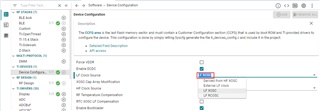Other Parts Discussed in Thread: SYSCONFIG
Hi all,
I am back at CC26x2r after a while
I have a quick question, well, 4 small ones, since sometimes it takes a lot of attemps to connect my cc26x2r to a linux raspberry system. Such linux system seems to always work at min_ce 24 and max_ce 40 (x multiplier).
- Does using RCOSC in Sysconfig affect the probability of a successful connection?
- Does using RCOSC in Sysconfig affect the current consumption of the device? Can I have some approximate numbers?
- As far as I know, there is no option in cc26x2r to change the LF clock source, is there? If so, does using it affect the probability of a successful connection? What about the current consumption?
- I am planning to set the connection update parameter request in sysconfig to simply "accept all". Do you think this is wise? Can this increase the probability of successful connections?
Thanks a lot for your time and have a nice Friday!


